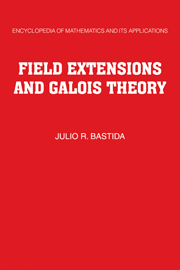Book contents
- Frontmatter
- Contents
- Editor's Statement
- Section Editor's Foreword
- Preface
- Historical Introduction
- Prerequisites
- Notation
- Field Extensions and Galois Theory
- Chapter 1 Preliminaries on Fields and Polynomials
- Chapter 2 Algebraic Extensions
- Chapter 3 Galois Theory
- Chapter 4 Transcendental Extensions
- References and Selected Bibliography
- Index
Section Editor's Foreword
Published online by Cambridge University Press: 05 June 2013
- Frontmatter
- Contents
- Editor's Statement
- Section Editor's Foreword
- Preface
- Historical Introduction
- Prerequisites
- Notation
- Field Extensions and Galois Theory
- Chapter 1 Preliminaries on Fields and Polynomials
- Chapter 2 Algebraic Extensions
- Chapter 3 Galois Theory
- Chapter 4 Transcendental Extensions
- References and Selected Bibliography
- Index
Summary
Galois theory is often cited as the beginning of modern “abstract” algebra. The ancient problem of the algebraic solution of polynomial equations culminated, through the work of Rufrini, Abel, and others, in the ideas of Galois, who set forth systematically the connection between polynomial equations and their associated groups. This was the beginning of the systematic study of group theory, nurtured by Cauchy and Jordan to its flowering at the end of the last century. It can also be viewed as the beginning of algebraic number theory (although here other forces were also clearly at work), developed later in the century by Dedekind, Kronecker, Kummer, and others. It is primarily this number-theoretic line of development that is pursued in this book, where the emphasis is on fields, and only secondarily on their groups.
In addition to these two specific outgrowths of Galois's ideas, there came something much broader, perhaps the essence of Galois theory: the systematically developed connection between two seemingly unrelated subjects, here the theory of fields and that of groups. More specifically, but in the same line, is the idea of studying a mathematical object by its group of automorphisms, an idea emphasized especially in Klein's Erlanger Program, which has since been accepted as a powerful tool in a great variety of mathematical disciplines.
Apart from the historical importance of the Galois theory of fields, its intrinsic interest and beauty, and its more or less direct applications to number theory, these many generalizations and their important applications give further compelling reasons for seeking an understanding of the theory in its classical form, as presented in this volume.
- Type
- Chapter
- Information
- Field Extensions and Galois Theory , pp. xv - xviPublisher: Cambridge University PressPrint publication year: 1984



